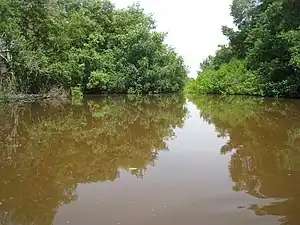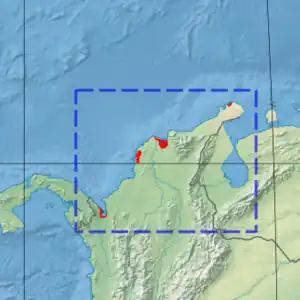Magdalena–Santa Marta mangroves
The Magdalena-Santa Marta mangroves ecoregion (WWF ID:NT1417) covers the mangrove forests along the coast of Colombia on the Caribbean Sea, from Gulf of Urabá in the west at the Colombia-Panama border to the Guajira Peninsula in the east.[1][2] [3] The region is relatively dry, with low precipitation and high evapotranspiration, so the mangroves depend for water and nutrients on the rivers flowing across the estuarine plain from the Sierra Nevada de Santa Marta mountains to the east. Efforts are currently underway to restore mangroves degraded by development and road building from the 1950s to 1980s.[3]
| Magdalena-Santa Marta mangroves | |
|---|---|
 | |
 Ecoregion territory (in red) | |
| Ecology | |
| Realm | Neotropic |
| Biome | Mangroves |
| Geography | |
| Area | 3,108 km2 (1,200 sq mi) |
| Country | Colombia |
| Coordinates | 11°N 75.75°W |
Location and description
Although this ecoregion stretches across 750 km of the Colombia coast, significant mangrove forests exist at only a few large sites. These sites are typically at the estuaries of large rivers or where low-lying plains meet the Caribbean. The main mangrove areas are (from southwest to northeast):
- Gulf of Urabá. Mangroves line the entire coast of this inlet, most deeply at the mouth of the Atrato River.
- Sinú River Delta. Mangroves heaviest in the broad swamp to the east of the river mouth. These first two mangrove areas are surrounded by the inland Magdalena–Urabá moist forests ecoregion.
- Gulf of Morrosquillo, supporting a small mangrove coast east of the mouth of the Sinu River. This site is immediately surrounded by the Guajira–Barranquilla xeric scrub ecoregion.
- Cartagena Bay and Rosario Islands, at the edge of the flat plain between the Sinu and Magdalena Rivers.
- Ciénaga Grande de Santa Marta, the "Large Marsh of Saint Martha" is at the mouth of the Magdalena River, and just east of the city of Barranquilla. A RAMSAR wetland of international importance.[4]
- Tayrona National Natural Park, at the flat coastal foot of the Sierra Nevada de Santa Marta mountain range, just east of the city of Santa Marta
- Honda Bay, on the Guajira Peninsula near the northern tip of Colombia, 60 km from the border with Venezuela.
Climate
The climate of the ecoregion is Tropical savanna climate - dry winter (Köppen climate classification (Aw)). This climate is characterized by relatively even temperatures throughout the year, and a pronounced dry season. The driest month has less than 60 mm of precipitation, and is drier than the average month.[5][6] Precipitation in the ecoregion is relatively low, 460-700 mm/year, with high evapotranspiration (1,400 mm/year).[1]
Flora and fauna
The mangroves are mixed forests, with characteristic species of red mangrove (Rhizophora mangle), black mangrove (Avicennia germinans), white mangrove (Laguncularia racemosa), and buttonwood (Conocarpus erectus). Almost half of the mangrove areas have been degraded in the past 40 years by increasing salinity and decreased flows in fresh water caused by human development.[3]
The mangroves are important nurseries for fish, with over 130 species of fish identified in the mangroves around Santa Marta alone.[1]
Protected areas
Officially protected areas covering portions of these mangrove sites include:
References
- "Magdalena-Santa Marta mangroves". World Wildlife Federation. Retrieved November 20, 2020.
- "Map of Ecoregions 2017". Resolve, using WWF data. Retrieved November 20, 2020.
- "Magdalena-Santa Marta mangroves". The Encyclopedia of Earth. Retrieved November 20, 2020.
- "Sistema Delta Estuarino del Río Magdalena, Ciénaga Grande de Santa Marta". RAMSAR Sites Information Service. Retrieved November 20, 2020.
- Kottek, M., J. Grieser, C. Beck, B. Rudolf, and F. Rubel, 2006. "World Map of Koppen-Geiger Climate Classification Updated" (PDF). Gebrüder Borntraeger 2006. Retrieved September 14, 2019.
{{cite web}}: CS1 maint: multiple names: authors list (link) - "Dataset - Koppen climate classifications". World Bank. Retrieved September 14, 2019.